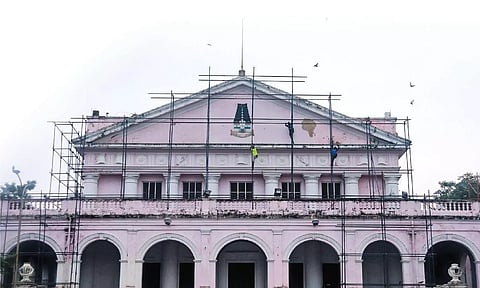

CHENNAI: One of the landmarks of the city and a heritage structure, Rajaji Hall in Omandurar Government Estate will be restored by December 2024, the Public Works Department (PWD) said. The hall witnessed many historical events in the city and was often a venue for placing the mortal remains of eminent leaders for public view.
“The three-storey building spread over 3,987 square metres, is damaged owing to ageing. As the road level rose over the decades, the basement floor was getting waterlogged and the roof too was leaky. The conservation and renovation of the hall was started on June 22, 2023, with an estimated budget of Rs 17 crore. Now, the preliminary works and removal of plastering and roof strengthening are in progress. By December 2024, we will finish all the works and hand over the site to the Information and Public Relations department,” said Saraswathi, Joint Engineer, Planning and Design circle of the Public Works Department (PWD).
“Dismantling the deteriorated plastering from walls and ceiling is in progress now. Around 30 employees are working day and night. We are dismantling pressed tiles including base mortar and bitumen sheet without damaging the original roof structure. We also racked out the brick joints without damaging the brick masonry and cleaning the surface with a coir brush. After dismantling, we will re-plaster the ceiling and walls using lime mortar and will renew the Mangalore tile roofing,” she said.
“To avoid water leakage, we will provide water membrane treatment to the leaky terrace and will finish the top of Madras terrace roof with one course of machine-pressed tiles. To ease and repair wooden items such as hanging doors, and window shutters, we will fix furniture fittings and paint with synthetic enamel paint and renew existing joints. We will provide and fix in place teak wood joists/beams for Madras terrace. Further, we will relay the flooring and renew the cornice around the building on all levels,” said S Santhosh, site engineer, at Rajaji Hall.
Building of British-era Banquet Hall
Recalling the formation of Rajaji Hall, Saraswathi said, “During the end of the 18th century, Thomas Rumbald desired to move his country house from Fort St George to a calm and salubrious atmosphere. Hence, the Admiralty building located in the Garden Estate (now called the Government Estate) was purchased and named the Garden House. Subsequently, during Lord Edward Clive’s tenure, the Garden House became the official Governor’s residence in 1797-1798. Lord Clive desired to develop the Admiralty building and entrusted the job to his close friend Goldingham, a Danish Astronomer-cum-Engineer, who did the remodelling as well as extension to the Garden House in 1800 at the cost of 1,06,000 pagodas (Rs 3,18,000).
“In 1799, when the Srirangapattinam fell into the hands of Englishmen, Lord Clive intended to raise a memorial to mark the defeat of Tippu Sultan (1799) as well as his father’s (Robert Clive) victory at Plassey in 1757, which saw the establishment of British rule in India. Goldingham designed and built the commemoration building in the style of a Greek temple, with soaring flights of steps in the frontage, Corinthian and Ionic Columns, and frieze on the pediments detailing the army victories. The building was constructed in 1802-1803 for 74,000 pagodas (Rs 2,22,000) and served as a banqueting hall attached to the Governor’s residence,” she said.
The hall set the trend of imperial style that became a hallmark of British buildings all over the globe from Jamaica to Tasmania and from New York to South Africa. The monumental structure is still admired for its architectural features.
The main structure stands unaltered except for the remodelling done from 1875 to 1895 and the terrace enclosed by arcade verandas on all four sides in 1895.
The Banquet Hall was renamed Rajaji Hall by an order issued by the then Madras Government (G.O. Ms. No. 1222, PWD Dated 09.04.1948).
After independence, the hall was used for State Reception to VIPs, fairs, seminars, state functions, film shooting, etc.
Independence Day Museum to soon be a reality
Sources with the Department of Museums said that the detailed project report (DPR) is being readied to set up a full-fledged Independence Day Museum with an interactive display in the recently restored Humayun Mahal.
“The massive red structure, constructed in 1770, will soon become a museum. Since the restoration of the mahal, which was damaged in a fire in 2012, was completed an year ago, we were waiting for Chief Minister MK Stalin’s appointment to inaugurate it for public. In between, we started preparing a detailed project report to convert it into a museum. Once the work of converting the Hall into a full-fledged museum is done, CM will inaugurate this,” officials said.